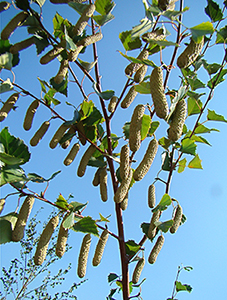Two subspecies of Betula pendula


Betula pendula subspecies fontqueri Spanish Birch
Origin of the species name
Betula is the Latin name for the genus and is derived from the ancient Gaul word for 'pitch' which refers to the bituminous content of the bark; pendula is Latin for hanging and refers to the drooping growth habit; fontqueri is named after the Spanish botanist Puis Font i Quer.
Family
Betulaceae
Date planted
August 2008
Lifespan
Unknown.



General description
This is a medium sized deciduous tree. The bark of the young trees is grey, smooth and shiny and then turns white. The serrated triangular leaves give a bright yellow autumn display. The flowers are wind-pollinated catkins which come out before the leaves in early spring and produce small winged seeds. Differs from ssp. pendula in characters of the seed. Height 25m Spread 10m.
Natural distribution and habitat
The subspecies fontqueri is native to Spain and Morocco where it is found in small populations in dry woodlands in three mountain systems in Spain and the Rif Mountains in Morocco.
Conservation status
The subspecies fontqueri is classified as endangered. The subpopulations are small and dispersed and the spread of housing developments, as well as the decline in water availability, fires, cutting and tourism, pose serious threats. A reintroduction program is being developed at Cordoba Botanic Garden, Spain.
Planting pattern
Planted in wavy lines, following the contours.
Uses
The bark has been used in making baskets, shoes and even as a substitute for paper. The leaves have been used for herbal tea for its diuretic effect.
Further reading
Rushforth, K. (1999). Trees of Britain and Europe. Collins.
HOST FOREST Betula pendula subspecies pendula Silver Birch


Origin of the species name
Betula is the Latin name for the genus and is derived from the ancient Gaul word for 'pitch' which refers to the bituminous content of the bark; pendula is Latin for hanging and refers to the drooping growth habit.
Family
Betulaceae
Date planted
August 2008
Lifespan
Silver birches have an expected lifespan of 60-70 years.

General description
This is a medium sized deciduous tree. The bark of the young trees is grey, smooth and shiny and then turns white. The serrated triangular leaves give a bright yellow autumn display. The flowers are wind-pollinated catkins which come out before the leaves in early spring and produce small winged seeds. Height 25m Spread 10m.
Natural distribution and habitat
This subspecies occurs naturally in almost all countries of Europe from the Mediterranean to Scandinavia It is most abundant in northern Europe, in almost continuous mixed forests and in fairly large pure stands. In the western and southern parts of the range it is patchy and in the south, silver birch is found mostly at higher altitudes.
Conservation status
It is not classified as a threatened species.
Planting pattern
Planted in wavy lines following the contours.
Uses
The bark has been used in making baskets, shoes and even as a substitute for paper. The leaves have been used for herbal tea for its diuretic effect.
Further reading
Rushforth, K. (1999). Trees of Britain and Europe. Collins.
